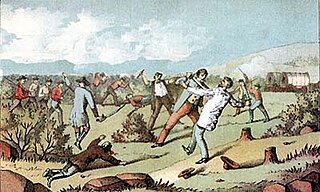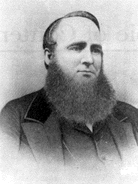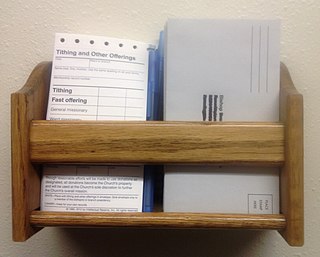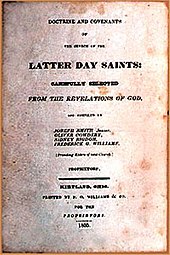In the Latter Day Saint movement, priesthood is the power and authority of God given to man, including the authority to perform ordinances and to act as a leader in the church. A group of priesthood holders is referred to as a quorum.

The Danites were a fraternal organization founded by Latter Day Saint members in June 1838, in the town of Far West, Caldwell County, Missouri. During their period of organization in Missouri, the Danites operated as a vigilante group and took a central role in the events of the 1838 Mormon War. They remained an important part of Mormon and non-Mormon folklore, polemics, and propaganda for the remainder of the 19th century, waning in ideological prominence after Utah gained statehood. Notwithstanding public excommunications of Danite leaders by the Church and both public and private statements from Joseph Smith referring to the band as being both evil in nature and a "secret combination", the nature and scope of the organization and the degree to which it was officially connected to the Church of Christ are not agreed between historians. Early in the group's existence, Joseph Smith appeared to endorse its actions, but later turned against it as violence increased and the actions of the Danites inspired a hysteria in Missouri that eventually led to the Extermination Order. According to an essay on the website of the Church of Jesus Christ of Latter-day Saints, "Historians generally concur that Joseph Smith approved of the Danites but that he probably was not briefed on all their plans and likely did not sanction the full range of their activities."

In Mormonism, the endowment is a two-part ordinance (ceremony) designed for participants to become kings, queens, priests, and priestesses in the afterlife. As part of the first ceremony, participants take part in a scripted reenactment of the Biblical creation and fall of Adam and Eve. The ceremony includes a symbolic washing and anointing, and receipt of a "new name" which they are not to reveal to others except at a certain part in the ceremony, and the receipt of the temple garment, which Mormons then are expected to wear under their clothing day and night throughout their life. Participants are taught symbolic gestures and passwords considered necessary to pass by angels guarding the way to heaven, and are instructed not to reveal them to others. As practiced today in the Church of Jesus Christ of Latter-day Saints, the endowment also consists of a series of covenants that participants make, such as a covenant of consecration to the LDS Church. All LDS Church members who choose to serve as missionaries or participate in a celestial marriage in a temple must first complete the first endowment ceremony.

David Whitmer was a leader in the Church of Jesus Christ of Latter Day Saints who eventually became the most interviewed of the Three Witnesses to the Book of Mormon's golden plates.
Thomas Baldwin Marsh was an early leader in the Latter-day Saint movement and an original member of the Quorum of the Twelve Apostles, who served as the quorum's first president in the Church of the Latter Day Saints from 1835 to 1838. He withdrew from the church in 1838, was excommunicated from it in 1839, and remained disaffected for almost 19 years. Marsh was rebaptized into the Church of Jesus Christ of Latter-day Saints in July 1857, but never again served in church leadership positions.

The salt sermon was an oration delivered on 17 June 1838 by Sidney Rigdon, then First Counselor in the First Presidency of the Church of Jesus Christ of Latter Day Saints, and frequent spokesman for Joseph Smith, the founder of the Latter Day Saint movement, against church dissenters, including Book of Mormon witnesses Oliver Cowdery, David Whitmer, and John Whitmer, and other leaders including W. W. Phelps. The Salt Sermon is often confused with Rigdon's July 4th oration.

William Wines Phelps was an early leader of the Latter Day Saint movement. He printed the first edition of the Book of Commandments that became a standard work of the church and wrote numerous hymns, some of which are included in the current version of the Church of Jesus Christ of Latter-day Saints' hymnal. He was at times both close to and at odds with church leadership. He testified against Joseph Smith, providing evidence that helped persuade authorities to arrest Smith. He was excommunicated three times and rejoined the church each time. He was a ghostwriter for Smith. Phelps was called by Smith to serve as assistant president of the church in Missouri and as a member of the Council of Fifty. After Smith's death, Phelps supported Brigham Young, who was the church's new president.
Within the Latter Day Saint movement, Zion is often used to connote an association of the righteous. This association would practice a form of communitarian economics, called the United Order, which were meant to ensure that all members maintained an acceptable quality of life, class distinctions were minimized, and group unity achieved.

Amasa Mason Lyman was an early leader in the Latter Day Saint movement and was an apostle. He was also a counselor in the First Presidency to Joseph Smith.

Polygamy in the Church of Jesus Christ of Latter Day Saints, or plural marriage, is generally believed to have originated with the founder of Mormonism, Joseph Smith. According to several of his associates, Smith taught that polygamy was a divine commandment and practiced it personally, by some accounts marrying more than 30 women, some of whom had existing marriages to other men. Evidence for Smith's polygamy is provided by the church's "sealing" records, affidavits, letters, journals, and diaries. However, until his death, Smith and the leading church quorums denied that he preached or practiced polygamy. Smith's son Joseph Smith III, his widow Emma Smith, and the Reorganized Church of Jesus Christ of Latter Day Saints challenged the evidence and taught that Joseph Smith had opposed polygamy. They instead claimed that Brigham Young, the head of the Church of Jesus Christ of Latter-day Saints, introduced plural marriage after Smith's death. In 1852, leaders of the Utah-based LDS Church publicly announced the doctrine of polygamy.

Edward Partridge Sr. was one of the earliest converts to the Latter Day Saint movement and served as the first Bishop of the Church.
The Church of Jesus Christ of Latter-day Saints teaches that Adam and Eve were the first man and the first woman to live on the earth and that their fall was an essential step in the plan of salvation. Adam in particular is a central figure in Mormon cosmology. Robert L. Millet, a Latter-day Saint author, wrote of the church's perspective:
Few persons in all eternity have been more directly involved in the plan of salvation—the creation, the fall, and the ultimate redemption of the children of God—than the man Adam. His ministry among the sons and daughters of earth stretches from the distant past of premortality to the distant future of resurrection, judgment, and beyond.

The Temple Lot, located in Independence, Missouri, is the first site to be dedicated for the construction of a temple in the Latter Day Saint movement. The area was dedicated on August 3, 1831, by the movement's founder, Joseph Smith. It was purchased on December 19, 1831, by Edward Partridge to be the center of the New Jerusalem or "City of Zion" after Smith said he received a revelation stating that it would be the gathering spot of the Latter Day Saints during the last days.
In the theology of the Latter Day Saint movement, an endowment refers to a gift of "power from on high", typically associated with the ordinances performed in Latter Day Saint temples. The purpose and meaning of the endowment varied during the life of movement founder Joseph Smith. The term has referred to many such gifts of heavenly power, including the confirmation ritual, the institution of the High Priesthood in 1831, events and rituals occurring in the Kirtland Temple in the mid-1830s, and an elaborate ritual performed in the Nauvoo Temple in the 1840s.

This is a chronology of Mormonism. In the late 1820s, Joseph Smith, founder of the Latter Day Saint movement, announced that an angel had given him a set of golden plates engraved with a chronicle of ancient American peoples, which he had a unique gift to translate. In 1830, he published the resulting narratives as the Book of Mormon and founded the Church of Christ in western New York, claiming it to be a restoration of early Christianity.

The White Horse Prophecy is the popular name of an influential but disputed version of a statement on the future of the Latter Day Saints and the United States. It was given by Edwin Rushton in about 1900, and supposedly made in 1843 by Joseph Smith, Jr., the founder of the Latter Day Saint movement.

The Independence Visitors' Center is a visitors' center owned and operated by the Church of Jesus Christ of Latter-day Saints in Independence, Missouri. The center is situated on the Greater Temple Lot dedicated and purchased by Joseph Smith and his associates in 1831, only a few yards from the Church of Christ 's headquarters and the Community of Christ temple.

Tithing is a commandment accepted by various churches in the Latter Day Saint movement. In practicing tithing, adherents make willing tithe donations, usually ten percent of their income, to their church. It is based on both the biblical practice of paying tithes and modern revelation given to Joseph Smith and his accepted successors. For many of these churches, the law of tithing replaced or supplemented the law of consecration. The Church of Jesus Christ of Latter-day Saints emphasized tithing in the 1900s and 1960s to assist in paying church debts.











